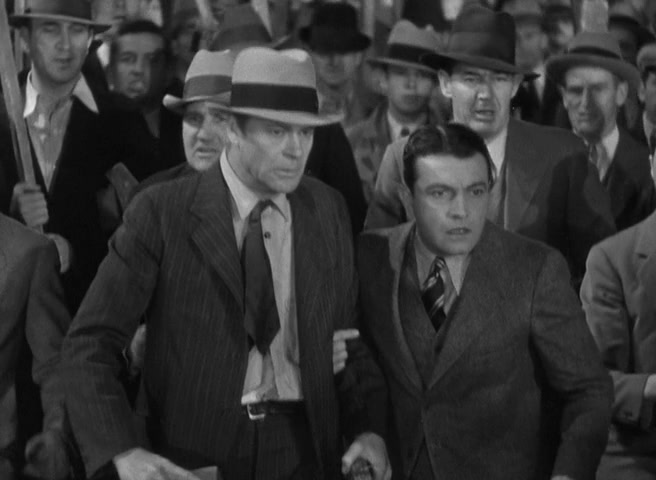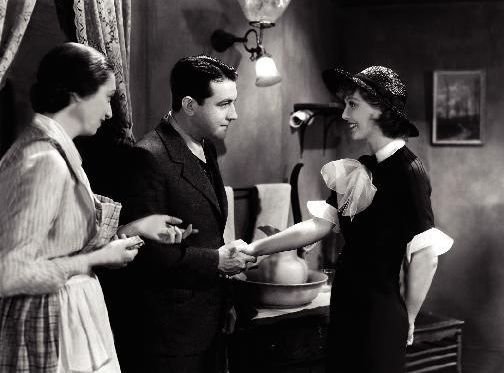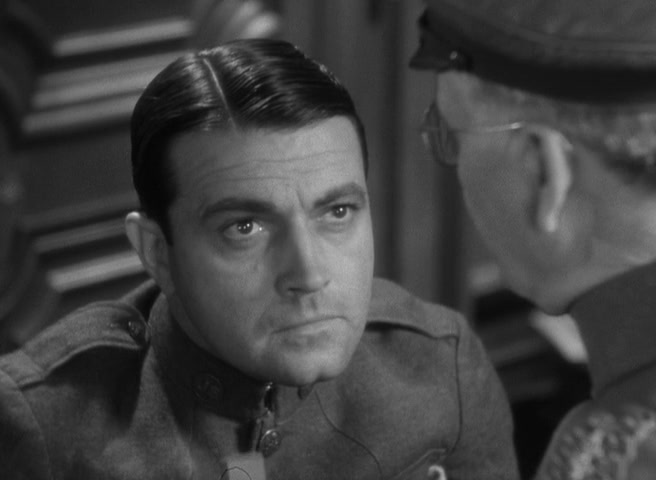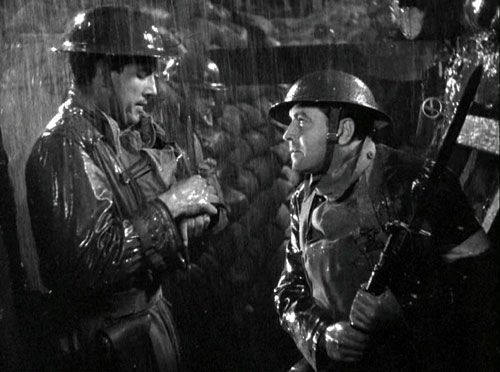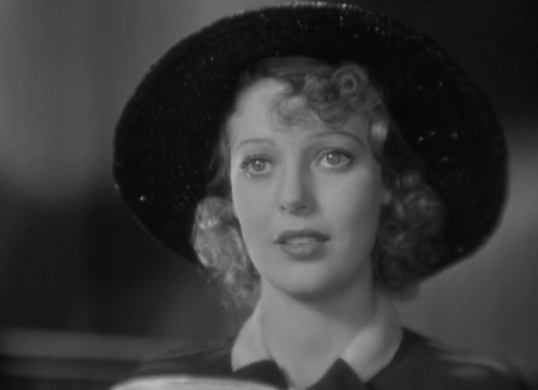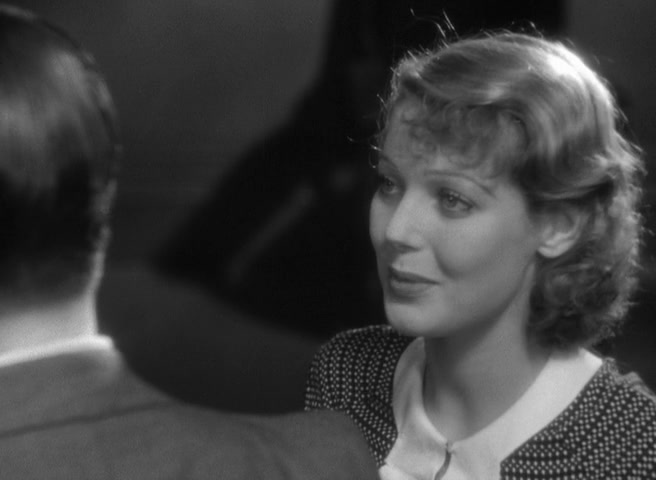Nutshell Review: Heroes for Sale (1933)
Director: William Wellman
Starring: Richard Barthelmess, Loretta Young, Aline MacMahon, Robert Barrat
Studio: Warner Bros
My IMDB Rating: 7
Viewing: Forbidden Hollywood Vol. 3 (Warner Bros Home Ent)
Plot: Tom Holmes (Barthelmess) is a good soldier, willing to lay down his life in a foxhole in WWI on a suicide mission. Roger (Gordon Wescott) is a coward who gets Tom shot, leaving him for dead, taking Tom’s glory and medals, albeit with a guilty conscience. That’s the first 5 minutes of Wellman’s tight 70 minutes of non-stop social commentary. Tom doesn’t die, but he is left with a morphine addiction, compliments of the German doctors who nurse him back to health while the war winds down. Back home in Milford, Roger is kind enough to get Tom a job at his father’s bank, but the drug addiction temps Tom to steal cash, he is dismissed and taken to the hospital to be cured. While in hospital Tom’s mother dies, so he leaves for Chicago to start fresh, meeting Ruth (Young) his first night in town. Immediately smitten, Ruth steals his heart, but gets him a job at the laundry she works at. Tom rises quickly and partners with Max, a communist inventor (Barrat), to revolutionize the laundry business, but insures that no jobs will be lost in the automation. Meanwhile Tom has married Ruth and had a son, Bill.
When the benevolent laundry owner drops dead of a heart attack, Tom’s contract to protect the workers is thrown out, they riot & Ruth is killed. Tom is sent to prison for 5 years for inciting the riot, which he was trying to prevent. After serving 5 years in prison, Tom reunites with his son Bill, who is staying with his former landlady, Mary (MacMahon). Max has been saving Tom’s percentage of the licensing fees form their invention and has adopted the trappings of capitalism, condemning communists as nothing more than capitalists without money. Deep in the depression, Mary has been feeding the forgotten men with leftovers from her diner & Tom decides to fund the enterprise with his money. Threatened by the red squad, Tom has to leave town to protect Bill and Mary. Penniless, he wanders from town to town until he runs into Roger, also a hobo, while they both struggle to stay dry under a viaduct. Tom immediately recognizes that while he had every road block thrown in front of him & Roger was born with a silver spoon, they have both ended up in the same place and that gives him peace. The closing scene is in Mary’s diner, when a plaque of Tom looks over she & Bill as they sing Tom’s praises as a great man.
Thoughts: For a 70 minute movie, Wellman & screenwriter Robert Lord fit just about every social issue imaginable into the story, handling most of them with a deft touch (for the 1930’s). From communism to the Great Depression, each issue is given a short representation, which only adds to their poignancy. The futility of trench warfare and absurdity of military chain of command, for instance, send Tom on his downward spiral in the opening 5 minutes. Similarly, the drug addiction that results from his injuries (forced upon him by Roger’s cowardice) is treated with disdain by Tom’s colleagues at the bank, as well as the bank president, who coldly notes that “it’s time for you boys to realize the war is over.” Clearly, as a WWI veteran, Wellman may have suffered some of the same prejudice when he returned from the war, so the fact that the bank president commits suicide in disgrace is no small coincidence.
The Great Depression, on the other hand, is front & center once Tom is released from prison, with Pa Dennis (Charley Grapewin) comically sharing food from the diner pantry with needy locals. As the need grows, first evident in Tom’s discouraging comments about getting work, then later in the growing line of hungry people outside the diner each night, Mary’s generosity becomes clear and reflects the benevolent face of humanity. Finally, when Tom is forced from his home by the red squad, he must live the life of a hobo, a forgotten man, surviving on hand outs and living under a viaduct. Wellman visually paints the inhumanity towards the less fortunate during the depression as Tom travels across the country, by showing billboards, no help wanted signs, and the cold faces of the wary, committed to protecting what little they have in the face of so much want.
While Warner Bros. was known to rip its stories right from the headlines of the day, Heroes for Sale is as matter of fact as even Warners would dare show conditions in America. The in your face relentlessness of the depression’s impact on good people is balanced by Pa & Ruth as they are always looking for the good in people, but with Ruth’s death that balance is thrown off and Tom’s sense of place suffers. It is only in the redemptive giving that Tom puts that balance back in place, even while he cannot fully join in the life of the community. While his heroism was once for sale, it has been placed above commerce in self-sacrificing goodness.
For Wellman, Heroes For Sale was one of almost 20 pictures he made for Warner Bros during a 3+ year period in the 1930’s and it’s social relevance makes it stand out. While he often sprinkled social commentary into his pictures (medical malpractice in Night Nurse), Heroes For Sale goes beyond mere Warner programmer to make a point about humanity and the depression’s impact on it.
Social Issues: depression, forgotten man, bread lines, labor unrest, communism, capitalism.
Category: Pre-Code
See Also: Beggars of Life, Gold Diggers of 1933, Wild Boys of the Road
Random Notes & Quotes:
*Loretta Young was known to keep a “swear jar” on the sets of her movies to collect coins when one of the actors, crew or director let loose with a curse word.
*While making Heroes For Sale Wellman was walking the backlot at Warner Bros. when he noticed a chorus girl on break from filming Busby Berkeley & Mervyn LeRoy’s Gold Diggers of 1933. Dottie Coonan was her name and she was 18. After his divorce was final mere days later, she agreed to go on a date. They would be married until his death 41 years later and have 7 kids together.
Director: William Wellman
Starring: Richard Barthelmess, Loretta Young, Aline MacMahon, Robert Barrat
Studio: Warner Bros
My IMDB Rating: 7
Viewing: Forbidden Hollywood Vol. 3 (Warner Bros Home Ent)
Plot: Tom Holmes (Barthelmess) is a good soldier, willing to lay down his life in a foxhole in WWI on a suicide mission. Roger (Gordon Wescott) is a coward who gets Tom shot, leaving him for dead, taking Tom’s glory and medals, albeit with a guilty conscience. That’s the first 5 minutes of Wellman’s tight 70 minutes of non-stop social commentary. Tom doesn’t die, but he is left with a morphine addiction, compliments of the German doctors who nurse him back to health while the war winds down. Back home in Milford, Roger is kind enough to get Tom a job at his father’s bank, but the drug addiction temps Tom to steal cash, he is dismissed and taken to the hospital to be cured. While in hospital Tom’s mother dies, so he leaves for Chicago to start fresh, meeting Ruth (Young) his first night in town. Immediately smitten, Ruth steals his heart, but gets him a job at the laundry she works at. Tom rises quickly and partners with Max, a communist inventor (Barrat), to revolutionize the laundry business, but insures that no jobs will be lost in the automation. Meanwhile Tom has married Ruth and had a son, Bill.
When the benevolent laundry owner drops dead of a heart attack, Tom’s contract to protect the workers is thrown out, they riot & Ruth is killed. Tom is sent to prison for 5 years for inciting the riot, which he was trying to prevent. After serving 5 years in prison, Tom reunites with his son Bill, who is staying with his former landlady, Mary (MacMahon). Max has been saving Tom’s percentage of the licensing fees form their invention and has adopted the trappings of capitalism, condemning communists as nothing more than capitalists without money. Deep in the depression, Mary has been feeding the forgotten men with leftovers from her diner & Tom decides to fund the enterprise with his money. Threatened by the red squad, Tom has to leave town to protect Bill and Mary. Penniless, he wanders from town to town until he runs into Roger, also a hobo, while they both struggle to stay dry under a viaduct. Tom immediately recognizes that while he had every road block thrown in front of him & Roger was born with a silver spoon, they have both ended up in the same place and that gives him peace. The closing scene is in Mary’s diner, when a plaque of Tom looks over she & Bill as they sing Tom’s praises as a great man.
Thoughts: For a 70 minute movie, Wellman & screenwriter Robert Lord fit just about every social issue imaginable into the story, handling most of them with a deft touch (for the 1930’s). From communism to the Great Depression, each issue is given a short representation, which only adds to their poignancy. The futility of trench warfare and absurdity of military chain of command, for instance, send Tom on his downward spiral in the opening 5 minutes. Similarly, the drug addiction that results from his injuries (forced upon him by Roger’s cowardice) is treated with disdain by Tom’s colleagues at the bank, as well as the bank president, who coldly notes that “it’s time for you boys to realize the war is over.” Clearly, as a WWI veteran, Wellman may have suffered some of the same prejudice when he returned from the war, so the fact that the bank president commits suicide in disgrace is no small coincidence.
The Great Depression, on the other hand, is front & center once Tom is released from prison, with Pa Dennis (Charley Grapewin) comically sharing food from the diner pantry with needy locals. As the need grows, first evident in Tom’s discouraging comments about getting work, then later in the growing line of hungry people outside the diner each night, Mary’s generosity becomes clear and reflects the benevolent face of humanity. Finally, when Tom is forced from his home by the red squad, he must live the life of a hobo, a forgotten man, surviving on hand outs and living under a viaduct. Wellman visually paints the inhumanity towards the less fortunate during the depression as Tom travels across the country, by showing billboards, no help wanted signs, and the cold faces of the wary, committed to protecting what little they have in the face of so much want.
While Warner Bros. was known to rip its stories right from the headlines of the day, Heroes for Sale is as matter of fact as even Warners would dare show conditions in America. The in your face relentlessness of the depression’s impact on good people is balanced by Pa & Ruth as they are always looking for the good in people, but with Ruth’s death that balance is thrown off and Tom’s sense of place suffers. It is only in the redemptive giving that Tom puts that balance back in place, even while he cannot fully join in the life of the community. While his heroism was once for sale, it has been placed above commerce in self-sacrificing goodness.
For Wellman, Heroes For Sale was one of almost 20 pictures he made for Warner Bros during a 3+ year period in the 1930’s and it’s social relevance makes it stand out. While he often sprinkled social commentary into his pictures (medical malpractice in Night Nurse), Heroes For Sale goes beyond mere Warner programmer to make a point about humanity and the depression’s impact on it.
Social Issues: depression, forgotten man, bread lines, labor unrest, communism, capitalism.
Category: Pre-Code
See Also: Beggars of Life, Gold Diggers of 1933, Wild Boys of the Road
Random Notes & Quotes:
*Loretta Young was known to keep a “swear jar” on the sets of her movies to collect coins when one of the actors, crew or director let loose with a curse word.
*While making Heroes For Sale Wellman was walking the backlot at Warner Bros. when he noticed a chorus girl on break from filming Busby Berkeley & Mervyn LeRoy’s Gold Diggers of 1933. Dottie Coonan was her name and she was 18. After his divorce was final mere days later, she agreed to go on a date. They would be married until his death 41 years later and have 7 kids together.

